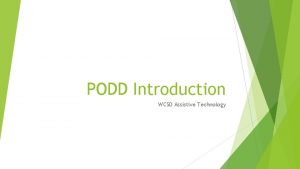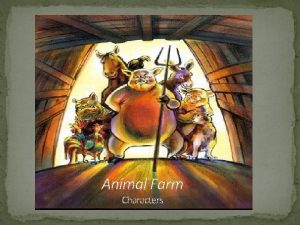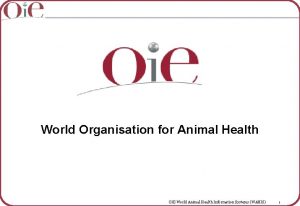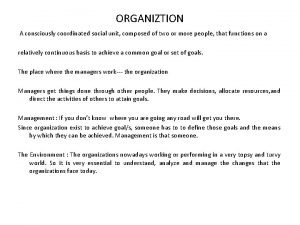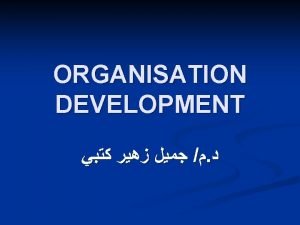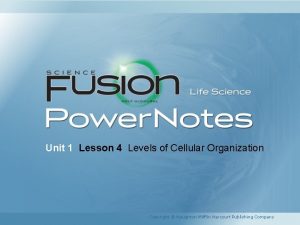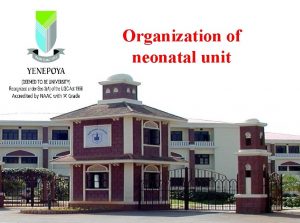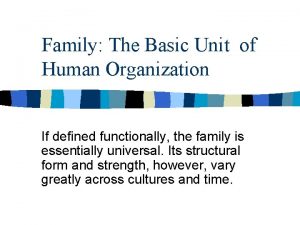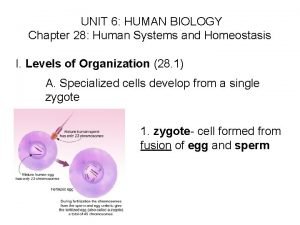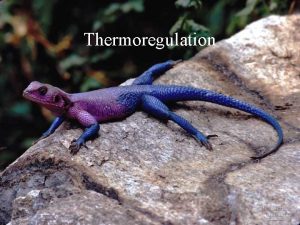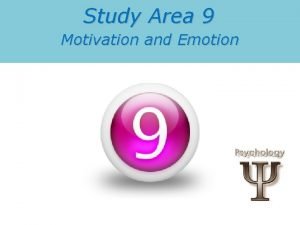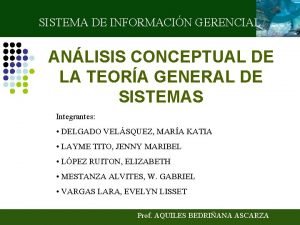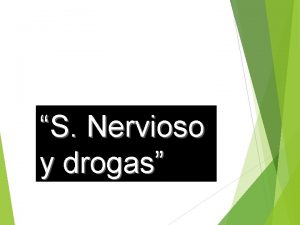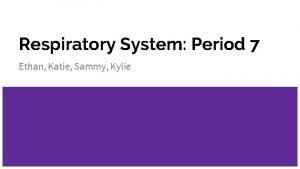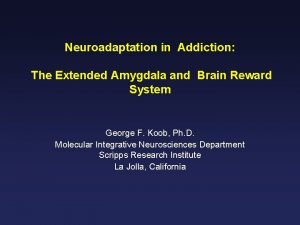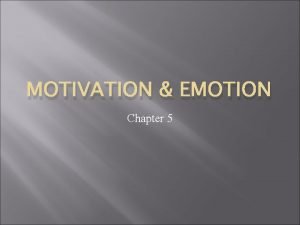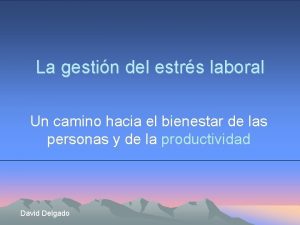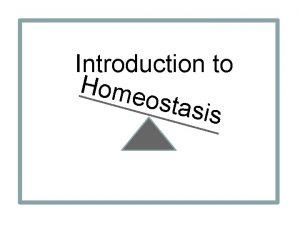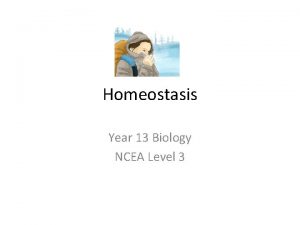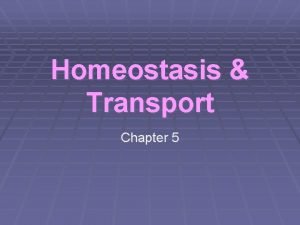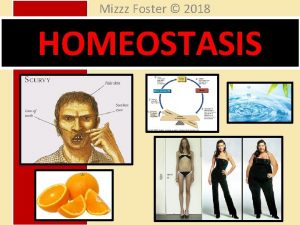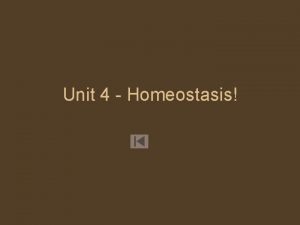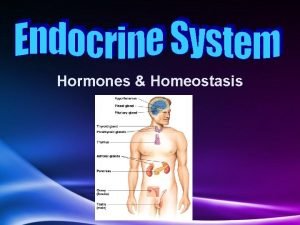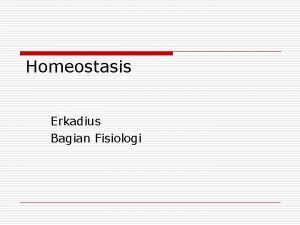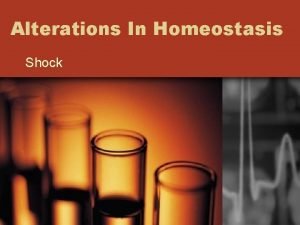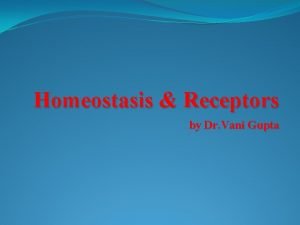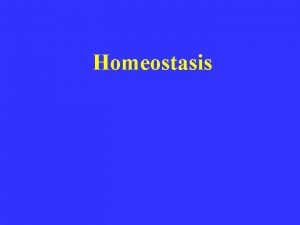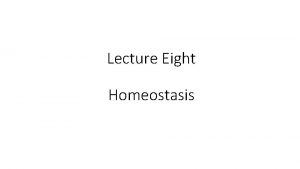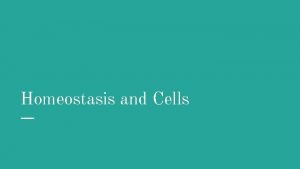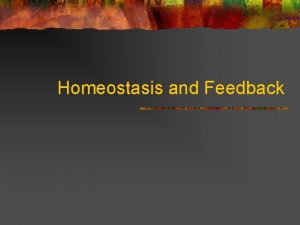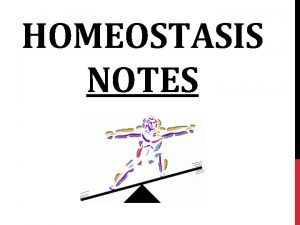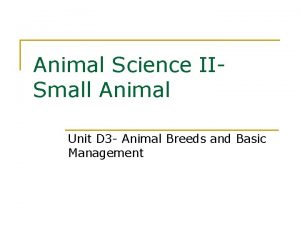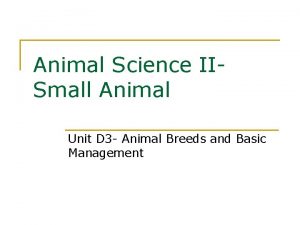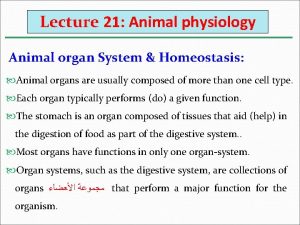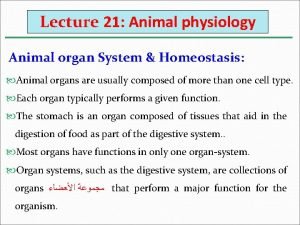Unit 5 Dynamic Homeostasis Animal Organization Homeostasis Unit

































- Slides: 33

Unit 5 Dynamic Homeostasis

Animal Organization & Homeostasis Unit Main Ideas – Think/Pair/Share What is Homeostasis? How is homeostasis different in single-celled organisms vs. multicellular organisms? What unique challenges to maintaining homeostasis do multicellular organisms have to address? 2

Animal Organization & Homeostasis Introduction Homeostasis is the maintenance of a constant internal environment. Every living thing must maintain homeostasis by regulating body temperature, level of food/water, level of needed gases, etc. Death results when homeostasis is not maintained 3

Animal Organization & Homeostasis 4 Homeostasis in Single vs Multi-Celled Multi-Cellular Organisms Single Celled Organisms are able to maintain must take care of all homeostasis in teams aspects of homeostasis of specialized cells alone. The organelles called tissues. Each cell within the single cell only has one job must regulate water, air, (digestion, transport, food, p. H, and etc). However, this temperature. It has no means they need to be cells to help, but it also able to coordinate their does not have to efforts, so they have to coordinate anything. be able to communicate with one another.

Animal Organization & Homeostasis in Single vs Multi-Celled • Organization helps multi-cellular organisms improve cell efficiency and coordination • Cells Tissues Organ systems Organism 5

Animal Organization & Homeostasis 6 REVIEW: Levels of Organization • Tissue - Group of similar cells performing a similar function • Organ - Group of tissues performing a specialized function • Organ System - Collection of several organs functioning together • Organism - A collection of organ

Anatomy and Physiology Animal Organization & Homeostasis 7 In order to understand how multicellular organisms function, we need to understand how they are put together. Anatomy – The study of the specific parts of a multicellular organism (e. g. What is a Kidney? ) Physiology – the study of the function of the specific parts of a multicellular organism (e. g. How does the kidney work? )

Animal Organization & Homeostasis Anatomy – Relevant Parts Major Types of Tissue 1. Epithelial tissue covers body surfaces and lines body cavities. (skin) 2. Connective tissue binds and supports body parts. (tendons) 3. Muscular tissue causes motion in body parts. (biceps) 4. Nervous tissue responds to stimuli and transmits impulses for communication/control. (brain) 8

Animal Organization & Homeostasis Epithelial Tissue 9 Epithelial tissue: Forms a continuous layer over body surfaces Lines inner cavities Forms glands Covers abdominal organs

Epithelial Tissue Example 1. Squamo us epithelium is composed of flat cells (e. g. , air sac linings of lungs, walls of capillaries). Animal Organization & Homeostasis 10

Epithelial Tissue Example 2. Cuboidal epithelium has cubeshaped cells. Animal Organization & Homeostasis 11

Epithelial Tissue Example Columnar epithelium has elongated cells that resemble pillars or columns (e. g. , small intestine). Used for absorption Animal Organization & Homeostasis 12

Animal Organization & Homeostasis Figure 33. 1 d 13

Special Epithelial Tissues Animal Organization & Homeostasis 14 1. Ciliated Epithelia - cells are covered with cilia (e. g. , lining of human respiratory tract). Cilia can bend and move material over the surface of the epithelium. 2. Glandular Epithelia - can be unicellular or have multicellular glands. Glands are a single cell or a group of cells that secrete a chemical signal into the body; two types: Exocrine glands secrete their products into ducts or directly into a tube or cavity. Endocrine glands secrete their product directly into the bloodstream.

Animal Organization & Homeostasis Connective Tissue 15 • Connective tissues bind and connect cells together

Diagram of Fibrous Connective Tissue 16

Animal Organization & Homeostasis 17 Special Connective Tissue Adipose Tissue Fat cells; stores energy, insulates the body, and provides padding Cartilage Classified according to type of collagen and elastic fibers found in the matrix Cartilage cells (chondrocytes), lie in small chambers (lacunae) in the

Figure 33. 4 19 Blood - Actually a connective tissue in which cells are embedded in a liquid matrix (plasma) Red blood cells - erythrocytes White blood cells - leukocytes Transports nutrients and oxygen to cells Removes carbon dioxide and other wastes

Animal Organization & Homeostasis Muscular Tissue 20 Contractile cells containing actin and myosin filaments (cytoskeleton fibers made to contract and release) used for movement Types Skeletal Muscle Voluntary - Long, striated fibers Smooth Muscle Involuntary - No striations Cardiac Muscle Involuntary, but more similar in structure to skeletal muscle

Animal Organization & Homeostasis Nervous Tissue is used for fast cell to cell communication Made mostly of cells called neurons that function through electrical impulses 22

Animal Organization & Homeostasis Nervous Tissue Nervous system has three functions 1. Sensory input – receive stimulus Sensory receptors detect changes in the environment Transmit info to the spinal cord 2. Data integration – make a decision Spinal cord and brain integrate information Decision is made regarding appropriate response 3. Motor output – respond to stimulus Response is transmitted to effector (reactionary cells, e. g. muscles) 23

24 Neurons and Neuroglia Long axons and dendrites form neuron fibers; bound by connective tissue, they form nerves.

Animal Organization & Homeostasis Organ Systems 25 The organ systems of the human body contribute to homeostasis by linking organs that form a specific task The digestive system Takes in and digests food Provides nutrients The respiratory system Adds oxygen to the blood Removes carbon dioxide

Animal Organization & Homeostasis Organ Systems 26 The Excretory (Liver and Kidneys) System Store excess glucose as glycogen Later, glycogen is broken down to replace the glucose used The hormone insulin regulates blood sugar Creates bile to digest fat (Kidneys) excrete wastes and salts to regulate water level

Animal Organization & Homeostasis Organ Systems The nervous system Communicates and controls body The circulatory system Transports oxygen and nutrients throughout the body 27

Animal Organization & Homeostasis Organ Systems The skeletal system Provide support and protection The integumentary system Production of hormones and communication signals Provides protection The immune system Protection from disease 28

Animal Organization & Homeostasis Controlling the function of Organ Systems POSITIVE AND NEGATIVE FEEDBACK REGULATION 29

Animal Organization & Homeostasis 30 Negative Feedback Homeostatic Control Partially controlled by hormones (and) Ultimately controlled by the nervous system Negative Feedback is the primary homeostatic mechanism that keeps a variable close to a set value (e. g. constant temperature) Sensor detects change in environment Regulatory Center activates an effector Effector reverses the change Negative = NO CHANGE ALLOWED

Negative Feedback Mechanisms: Simple 31

32 Negative Feedback Mechanism Analogy: a thermostat

33 Same diagram, but now featuring Regulation of Body Temperature

34

Animal Organization & Homeostasis Positive Feedback 35 During positive feedback, an event increases the likelihood of another event occurring Childbirth Process Urge to urinate Positive Feedback Does not result in equilibrium; YES TO CHANGE Does not occur as often as negative feedback
 Bioflix activity homeostasis hormones and homeostasis
Bioflix activity homeostasis hormones and homeostasis Bioflix activity homeostasis hormones and homeostasis
Bioflix activity homeostasis hormones and homeostasis Homeostasis example
Homeostasis example Homeostasis in animals
Homeostasis in animals Transferered
Transferered Pragmatic organization dynamic display
Pragmatic organization dynamic display Who is mr whymper in animal farm
Who is mr whymper in animal farm Process organization in computer organization
Process organization in computer organization Alternating pattern essay
Alternating pattern essay World animal health information system
World animal health information system Plant cell animal cell venn diagram
Plant cell animal cell venn diagram Venn diagram for plant and animal cells
Venn diagram for plant and animal cells Animal rights versus animal welfare
Animal rights versus animal welfare Dynamic unit testing
Dynamic unit testing Unit 10, unit 10 review tests, unit 10 general test
Unit 10, unit 10 review tests, unit 10 general test Organization as a social unit
Organization as a social unit Organization as a social unit
Organization as a social unit Lesson 4 levels of development
Lesson 4 levels of development Organization of neonatal unit
Organization of neonatal unit Basic unit of organization in society
Basic unit of organization in society Chapter 28 human systems and homeostasis
Chapter 28 human systems and homeostasis Countercurrent exchange thermoregulation
Countercurrent exchange thermoregulation Things that attract or lure people into action are
Things that attract or lure people into action are Allostasis psychology
Allostasis psychology Teleología ejemplos
Teleología ejemplos Homeostasis del sistema nervioso
Homeostasis del sistema nervioso How the respiratory system maintains homeostasis
How the respiratory system maintains homeostasis Homeostasis vs allostasis
Homeostasis vs allostasis Homeostasis motivation
Homeostasis motivation Diferencia entre alostasis y homeostasis
Diferencia entre alostasis y homeostasis Elephant homeostasis
Elephant homeostasis Adminstror
Adminstror Level 3 homeostasis
Level 3 homeostasis Section 5-2 review active transport
Section 5-2 review active transport





